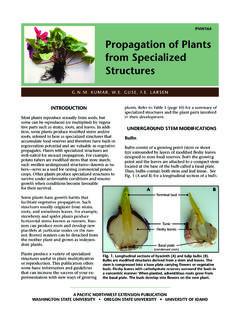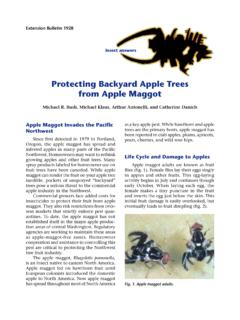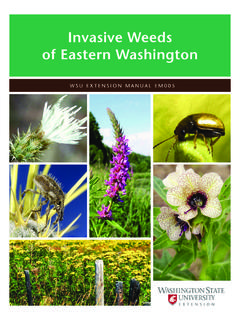Transcription of EB2023E CHIP BUD GRAFTING IN WASHINGTON …
1 1 GRAFTING in perennial fruit crops has been practiced since ancient times, originating with the Chinese and Greeks. In modern-day cropping systems, GRAFTING is often used to enhance fruit tree and vine productivity, confer disease or pest resistance, and tolerate certain soil types. As a component of GRAFTING , rootstocks were developed to improve fruit crop quality and survivability. Rootstocks consist of the lower portion of the tree or vine below the graft union that enhances plant tolerance and/or resistance to certain soil conditions or pests. Most of the grapes in WASHINGTON State are grown on their own roots (non-grafted) due to the limited presence of phylloxera. This aphid-like insect forms galls on roots and occasionally leaves, and can cause premature shoot defoliation, vine decline, and eventual death.
2 Since there are no chemicals to treat phylloxera, most growers simply graft wine grape varieties onto phylloxera-resistant rootstocks. Recently, chip bud GRAFTING in WASHINGTON State vineyards has been used to change existing varieties to a new variety to increase economic gain, depending upon market conditions and consumer needs. This method of plant propagation also shortens the time to production of the desired new crop, using the existing variety as a rootstock. Several grape varieties at the WASHINGTON State University (WSU) Irrigated Agriculture Research and Extension Center (IAREC) in Prosser have been successfully grafted onto selected rootstocks using this technique. GRAFTING Process GRAFTING combines two separate plant pieces, a scion and a rootstock (Figure 1).
3 The scion wood is the variety desired for fruit production, while the rootstock portion of the vine serves as its root system. During the GRAFTING process, callus is formed, which are undifferentiated cells that bind the scion and rootstock together. These cells differentiate into specialized cells that form a new xylem (water and nutrient pathway) and phloem (sugar pathway) within the graft union. Several different GRAFTING techniques can be used to produce complete grapevines or top-work varieties in the field. Bench GRAFTING of rootstocks and scions is often used in a nursery setting (Table 1). These vines are then callused in the nursery to develop the graft union before field planting.
4 Field GRAFTING is used on vines designated for top-working (Table 1), and requires protection with waterproof paraffin, paint, or GRAFTING tape. The graft union then calluses and differentiates into xylem and phloem in the field. Table 1. Different GRAFTING techniques used in producing grapevines with a rootstock. This bulletin concentrates on the chip bud GRAFTING technique, for which considerable experience and expertise exists at BUD GRAFTING IN WASHINGTON STATE VINEYARDSMERCY A. OLMSTEAD AND MARKUS KELLERG rapevine GRAFTING TechniquesBench graftingOmegaWhipField graftingChip budT-budCleftNotchBarkFigure 1. GRAFTING brings two different plants (a scion and rootstock) together.
5 EB2023E2 Chip Bud GRAFTING Chip bud GRAFTING in WASHINGTON State offers numerous benefits versus other forms of field or bench GRAFTING ( , notch, cleft, omega grafts; Figure 2A and 2B) because of the region s unique climate. Eastern WASHINGTON is often very dry (less than 10 of precipitation per year), classified as a high desert environment with temperatures that warm up and cool down rapidly throughout the day. With some types of field GRAFTING in this environment, the dark paint used to seal the wound (Figure 2A) can lead to failure of the graft union because of temperature fluctuations that cause swelling and shrinking, disrupting the cells connecting stock and scion. In western WASHINGTON , where fluctuations are not as extreme between day and night temperatures, cleft GRAFTING may be more successful than chip bud GRAFTING .
6 However, the chip budding technique simply involves wrapping the bud securely to the rootstock. Chip budding is also much easier and faster than cleft or notch GRAFTING because of the reduced surface area exposed and shorter healing most grape varieties are grown on their own roots in WASHINGTON State, returning to the original variety to adapt to changing market demands is feasible. All this requires is removing the scion portion of the vine and retraining the original variety from suckers at the base of the vine. In addition, chip bud GRAFTING is more economical than replanting. While it can take up to five years to replace a vineyard, including assessing soil conditions, constructing trellis and irrigation components, and making pre-plant decisions, chip-bud-grafted vines take only two to three years to achieve full production because an established vine is used for this technique.
7 In some cases, a reasonable crop will be produced in the year after GRAFTING . However, it is best to not overly stress the grapevine during vascular development at the graft union and to encourage rapid shoot growth. Therefore, any crop during the year GRAFTING is done should be removed. There is a fairly late window of opportunity for chip bud GRAFTING compared to other types of GRAFTING . For example, vineyards can be chip budded successfully in late May through mid-July, compared to cleft GRAFTING that should be completed by late May. If GRAFTING is conducted after mid-July, the vines may not harden off properly, leaving them susceptible to winter damage. Scion Wood PreparationChoosing Scion WoodField GRAFTING a vineyard to another desired variety requires planning at least one year in advance.
8 Scion wood should be collected in early winter (usually November) as dormant wood cuttings. At this point in the season, most of the carbohydrates are stored as starch. Collecting scion wood early in the winter helps to minimize various fungi and bacteria that cause rots and mildews that degrade the plant material and lead to graft failure. The form of carbohydrate (starch) during early winter is less preferable for fungi and bacteria to use as a food source, which can prevent growth of these microorganisms. Be sure to choose healthy vines for scion wood collection that have been tested virus-free. Avoid vines that show symptoms of disease, such as heavy powdery mildew infestations, and damage by frost or dehydration.
9 Canes should be about pencil-thick (9/16 3/8 in diameter), well-lignified, round, and straight (Figure 3). However, straight canes are less important for chip budding than other types of GRAFTING . Also choose canes where the internode length (distance between buds) is not more than . This helps to avoid the use of overly vigorous shoots (bull canes) or struggling shoots, which can indicate a nutrient deficiency, disease, or pest problem. Selecting thinner rather than thicker canes makes it easier to graft the associated buds. Cut the canes to include 4 5 buds each, for a total of 12 16 in length. Figure 2. Cleft GRAFTING (A) and omega GRAFTING (B) are GRAFTING techniques that can be used on grapevines.
10 BAFigure 3. Choose scion wood for GRAFTING that is 12 16 in length, round, and as straight as possible. Points to Remember: Take scion wood cuttings in early winter. Be sure the cuttings are from healthy vines that have been virus-tested and do not show symptoms of disease or damage. Choose canes that are round, straight, and thin (pencil thickness, 9/16 3/8 ). Choose canes that include 4 5 buds (12 16 in length).3 Preparing Scion Wood for StorageOnce the scion wood is cut and bundled (50 100 cuttings/bundle; Figure 3), apply a heat treatment to minimize pests and diseases. Place the wood in a water bath at 122 F (50 C) for 30 minutes to stop pathogenic fungi and minimize crown gall and certain phytoplasmas in the tissue.



